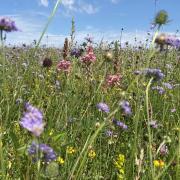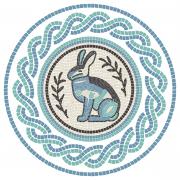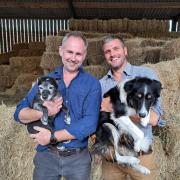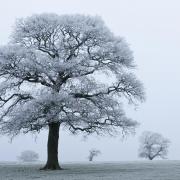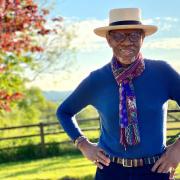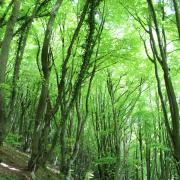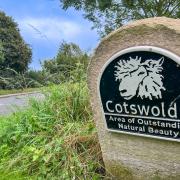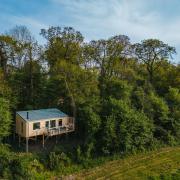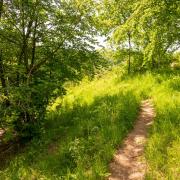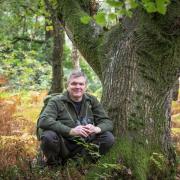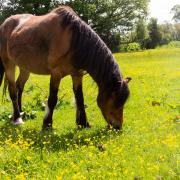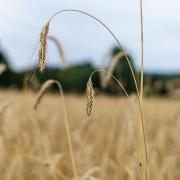Richard Keating chats to Siân Ellis about connecting art, landscape and community
There is a great quote by John Ruskin, says Richard Keating, co-founder of artist collective Walking the Land: ‘I would rather teach drawing that my pupils may learn to love nature, than teach the looking at nature that they may learn to draw.’
Ruskin’s comment, Richard says, ‘nicely opens up a view about us being a part of nature rather than separate, which then leads to an immersive practice.’ He quickly adds with a smile, ‘I suggest though that my relationship with people on [our] walks is as a fellow “explorer” rather than teacher/pupil.’

Walking the Land has been active in the Stroud Valleys since 2002, connecting art, landscape and community through projects, exhibitions and, since 2004, shared walks on the first Friday of every month. On these walks the creative processes stimulated by being in nature, encouraging deeper connection and care for our surroundings, are valued equally with drawings, paintings, words and other media produced as a result.
‘It is not just a visual thing; it is biological, an ecological connection, and about understanding what makes a place tick. The landscape is the main place where we can witness where our ways of life and other natural processes meet, and the results of that,’ Richard says.

IMMERSIVE EXPERIENCE
‘Walking the Land is a collaboration and different people involved have different skills,’ Richard continues. While he, his son Tom, and Kel Portman, all artists and with backgrounds in landscape, education and community, initiated the collective, it has since grown into a widespread group that comes together to focus on different creative projects.
Richard’s CV is an interesting blend of the practical, academic, artistic and environmental: segueing from art college to landscape architecture, and environmental and community management. A believer in lifelong learning, he was 60 when he embarked on his (since completed) PhD in Landscape Aesthetics in Practice.
‘I feel that aesthetic, which for me is about how we sense the world, has always been central to what I have been doing,’ he says. In his personal art practice there is tension in terms of media between using a camera and drawing and writing, while as a facilitator, he reiterates, his artist’s role is ‘getting people to experience nature first hand, the immersive experience.’

First Friday Walks are open to all, artists and non-artists alike, with groups limited to around a dozen.
‘A lot has been written about walking; it’s quite meditative. Sometimes we do “slow walking”, where we walk as slowly as possible and use all our senses, feeling the ground under us, seeing and listening: it’s a very powerful way of being in a place.’
Often participants are given a quote or theme, from a writer, philosopher or artist, for consideration as they walk, adding focus to reflections. Or a walk might include an archaeologist, farmer or ecologist talking about locations: another way to reach a deeper understanding of the landscape.

Recent Friday gatherings have included an 8km ‘Scratching the Surface’ walk through woodland and open countryside, with participants ‘invited to be mindful of the soil, rock and life forms beneath your feet, to examine and respond to their complexity and diversity.’ Among prompts for thought was a scientific report highlighting the fragility of soil as ‘a very vulnerable, living skin’ of the world.
In May, a 6km walk along the Cotswold escarpment and down through a beech-lined valley focused on Beltane and trees. Participants’ creative responses to the woodland were included in a Walking the Land project contributing words to The Festival of Words at Nailsworth (held July 5-10). Meanwhile April’s walk, around one of Stroud’s commons, linked thoughts to Ukrainians literally walking away from their homes. ‘Where do we feel embedded?’ was the question.
Some participants create art en route on Friday walks, maybe as simply as with a mobile phone; others create work later, to share privately within the group or as part of a public exhibition. People who consider themselves non-artists often surprise themselves, Richard says, or rediscover a forgotten enjoyment of drawing.
Watermarks, a recent artist collaboration assembling dynamic responses to walking our waters’ edges and invoking themes ranging from climate crisis to what is visible/invisible, became a focus for discussion in December at The Edge Conference at The University of the Highlands and Islands.
There is also a wider network of ‘remote walkers’, around the country and even as far away as Australia, who synchronise First Friday walks. During pandemic lockdowns monthly online Last Tuesday Café discussion events really took off too.

COMMUNITY AND CONSERVATION
Walking the Land artists have run numerous projects to engage whole communities in the landscape around them, helping to give them a say in decision making. While questionnaires that ask for point-blank answers have a role in such processes, drawing people in through art can be ‘more qualitative; people express things that would need a whole essay to say if you just used words,’ Richard says.
He recalls working with the Cotswolds Conservation Board as an example, when the Board was conducting landscape character appraisals as part of a management plan review. Artists walked the length of the River Frome and took work they produced to local events, eliciting responses that enriched the Board’s understanding of what places meant to people. A resulting drawing, bringing together technical descriptions of the landscape overlaid with people’s feelings about it, exemplified how ‘the creative process can open up surprising conversations or questions you wouldn’t necessarily think of asking,’ Richard says.
On another occasion people were invited to mark their favourite places – for wild swimming, cycling, views – on a map of the Cotswolds: ‘another, different way of collecting information.’


Walking the Land artists also worked with the recent nationwide Back from the Brink programme aimed at saving some of our most threatened species from extinction. Art created at Rough Bank nature reserve near Stroud, which is managed by the Gloucestershire branch of Butterfly Conservation, has been collected into a hauntingly evocative show reel (on WtL’s website).
Another, ongoing, community project, in support of Nailsworth Town Council’s tree-planting programme, involves artists collecting people’s feelings and views about tree cover and function, species and locations. From activities at July’s Nailsworth Festival of Words, to tree-focused walks and a visit to the local school, the aim is to enable everyone to have their say, to plant and care for trees, connecting people, nature and place.
Find out more about Walking the Land at walkingtheland.org.uk




